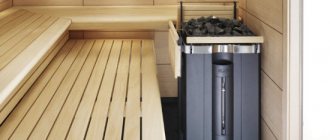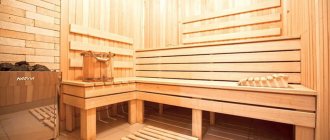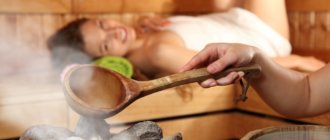What is the difference between pairs?
shutterstock.com
The general principle of such procedures is the effect of high temperatures on the skin and body. Steam rooms differ not only in temperature conditions, but also in air humidity.
- The main attribute of a Russian bath is wet steam: at an air temperature of 50–70°C, humidity reaches the same percentage values. In a Russian bathhouse, there is nowhere for sweat to evaporate: there is not enough temperature, plus high air humidity interferes. In this case, hot steam can have an aggressive effect on the skin, causing dilation of superficial vessels and an intense rush of blood to the skin of the face. For this reason, visiting the bathhouse is not recommended for people with rosacea and sensitive skin.
- In a Turkish hammam, the air temperature does not exceed 40–45 °C, and the humidity reaches 80–90%. The hammam is characterized by a low air temperature and a large amount of moisture, which condenses on surfaces that are less heated than the air. This applies to skin that collects not so much moisture as condensation. This steam room is comfortable for most people due to moderate temperature and high humidity: the skin does not dry out and blood vessels do not dilate. The hammam can be visited by people with sensitive, dry skin and rosacea.
- In a classic sauna, the temperature is 100–120 °C, and the humidity is only 10–15%. These conditions affect the body in different ways. It is easier for a person to be in a sauna: the air contains a lot of oxygen and little moisture. At high temperatures, intense sweat production occurs, which quickly evaporates from the surface of the skin. At the same time, the microclimate is harmful for those with sensitive, dry and couperose skin: dehydration of the body increases.
Visit steam rooms 1-2 times a week if you feel good in hot conditions: regardless of the type of steam room and the intensity of sweating, the body is cleansed of waste and toxins. It also cleanses the pores, exfoliates and softens rough areas of the skin, and moisturizes the skin.
Types of baths
Today there are several types of baths , but despite this, many choose Russian baths, along with which European ones remain popular. A person is drawn here for a reason - a family connection is felt here, and he is also attracted by a special atmosphere that is conducive to intimate conversations and a pleasant pastime.
Regardless of the bathhouse you want to go to, the same contraindications apply to all of them. A special feature of the Turkish bath is that it has several cabins with different temperatures. This demonstrates the main principle of Turkish baths, which states that the body should warm up gradually.
Although the contraindications for the Turkish bath are the same as for the Russian one, it brings no less health benefits. These baths have an elegant design. The room has a domed ceiling and three pools with water of different temperatures. First of all, people who suffer from respiratory diseases, asthma and other organs should be careful when visiting a Turkish bath. It is better for them not to take risks and choose a safer method of recovery.
What to do before and after visiting the steam room
shutterstock.com
In the intervals between steaming, you can do contrast hardening or rest at room temperature. This increases blood circulation in the skin, has a positive effect on metabolism and strengthens the immune system.
Before visiting the steam room, take a shower and cleanse your face. After steaming, water procedures are also recommended: the pores are wide open, and the sebaceous glands, narrowing, draw back harmful substances that are released with sweat. This leads to inflammation or worsening of the inflammatory process, for example, with acne. Warm skin absorbs nutrients more effectively, and after a shower it is recommended to apply skincare products: serums, creams or masks.
The main life hack for any steam room: use a broom to enhance the beneficial properties of steaming. The leaves and bark contain trace elements, phytoncides and aromatic oils that have a healing effect on the entire body.
After a sauna or bath, anti-cellulite and lymphatic drainage massages are especially useful, for example, in combination with body peeling.
Who can and who can't
Indications
When analyzing whether it is possible to steam, it is worth considering both the arguments “for” and the arguments “against”.
Let's start, perhaps, with something pleasant - who not only can, but also needs to go to the bathhouse:
- Sauna and bathhouse have a positive effect on the course of cardiovascular diseases - myocarditis, vegetative-vascular dystonia, coronary disease, etc. The main thing is that there are no signs of inflammation and heart failure. You can also go to the bathhouse if you have had a myocardial infarction, but only if at least six months have passed since it.
Advice! In any case, if there are diseases of the circulatory system, the heating mode should be gentle.
- For respiratory diseases, the bathhouse is practically a panacea: in the steam room you can treat and prevent allergic diseases, sinusitis, laryngitis, chronic bronchitis, etc. It is also worth visiting the sauna after recovery from pneumonia, bronchial asthma, inflammation of the upper respiratory tract, etc.
Massage treatments (pictured) are part of sports training
- Since the effectiveness of massage procedures in a bathhouse increases many times over, it is impossible not to use this for the treatment of diseases of the musculoskeletal system. The combination of a steam room and massage allows for effective correction of posture, increasing overall muscle tone (especially useful during sports activities), recovery from injuries, etc.
Advice! For rheumatism and arthritis, massage with brooms (birch, oak, nettle, etc.) is especially useful.
In addition, bath procedures can be recommended for the treatment of diseases of the nervous system, the prevention of kidney and liver failure, in obstetrics, gynecology, etc.
Contraindications
However, there are situations in which you will have to refuse a bath. They are connected, first of all, with the fact that the body simply cannot cope with the increased load exerted by the hot and humid air of the steam room.
Among these contraindications are:
- First of all, these are, of course, cardiovascular diseases associated with high blood pressure, namely hypertension. If your upper pressure reaches 200-220 mmHg, then a bathhouse, alas, is contraindicated for you.
If you feel unwell, it’s time to leave the steam room!
- The list of prohibitions also includes angina pectoris, acute heart failure and acute heart attack up to six months. Alas, in these conditions the heart may simply not be able to cope.
- As for the respiratory system, the list of prohibitions is somewhat smaller. It is not recommended to take a steam bath only when the viral disease is in full swing and the body is weakened.
Before visiting the steam room, it is better to consult a doctor
- Epilepsy, Parkinson's disease and some other nervous diseases can also cause a ban on visiting saunas and steam rooms. In the case of diseases of the brain and spinal cord, you should definitely consult with your doctor, as the consequences can be very sad.
- Other prohibitions include diseases of various organs and systems that are in the process of healing. It is better to completely undergo the medical procedures prescribed by your doctor, and only then recover in the steam room.
- Late pregnancy should also be included in this list. Don't risk the health of your unborn child!
Fungus
Speaking about the list of contraindications that any medical instruction for bath procedures contains, we should not forget about such an unpleasant disease as fungus:
It is necessary to combat foot fungus comprehensively
- Fungal diseases can be “caught” not only in public baths, but also in a private steam room. The thing is that spores are present on the skin of almost humans, and only when they enter the blood or mucous membranes of a person with a weakened immune system, they cause disease.
- In a warm and humid environment (namely, these are the conditions in a bathhouse), fungal spores feel very comfortable, and therefore, when they enter the body, they develop very quickly and increase their numbers.
- Risk factors include skin damage, calluses, varicose veins and other vascular diseases. If you fall into a “risk group”, you should treat your feet and other problem areas with antifungal ointments in advance, and also strictly observe the rules of personal hygiene.
- Well, if the fungus has already settled in you, then until the end of all treatment procedures you should forget about the steam room.
Treating the floor with a fungicide is very important!
Note! The bathhouse owner should also pay attention to the sanitary condition of the premises. To avoid outbreaks of fungal infections, it is necessary to control the humidity conditions and periodically perform disinfection.
Contraindications
shutterstock.com
The steam room is dangerous for people with hypertension and other problems with the heart and blood vessels. Those who have severe chronic diseases should visit steam rooms with special caution: diabetes mellitus, kidney disease, a history of cancer, neurological pathologies. If you have health problems, visit the steam room only after consulting a doctor.
Contraindications are also considered inflammatory skin diseases, exacerbation of acne and rosacea, wounds and fresh scars. Refrain from visiting the steam room during the recovery period after aggressive cosmetic procedures that result in damage to the integrity of the skin: chemical peels, laser resurfacing, injections. If you plan to visit the steam room, check with your cosmetologist about the duration of the rehabilitation period in your case.
How does a bath have a healing effect?
The sauna kingdom is not limited to just heat and steam. A whole army of positive factors is concentrated here! Caressing steam, the cradle of all life on Earth - water, healthy aromas and, of course, high temperatures.
Of course, all the bones are warmed up in the sauna! And this is achieved not only by warming the body with steam.
Thermal radiation from the heater provides wave heating of the body. Of course, we don’t notice this wave heating, but the force from the heated bath stones is considerable. Especially if the heater is filled with crimson quartzite or jadeite.
A steam room in a bathhouse with a broom cannot compare in efficiency with any other bath. In the steam room, the power of a broom, its targeted beneficial action treats ailments no worse than certified specialists.
I think that no one will dispute the fact that purity is a strong force. After all, it is cleanliness that the bathhouse gives us above all! Metabolic processes in the body are activated, blood circulation is stimulated, and the heated skin through the opened pores is actively cleansed of all uselessness.
With sweat, lactic acid (which causes fatigue), urea, metabolic end products, salts, etc. are released...
The body, freed from toxins, begins to work together and harmoniously. But, nevertheless, we get a huge, positive effect from emotional and mental relief. Many people associate the bathhouse only with positive emotions and traditions. Here the nervousness somehow goes away on its own and the tension is relieved.
Worries and adversities lose their significance and relevance. A positive attitude after a good steam room is a guarantee of a bath!
But you still need to know about contraindications to visiting baths and saunas...
The importance of the respiratory organs
Respiratory system
The human respiratory organs (respiratory system) are a set of organs that perform the function of external respiration. In a word, when you inhale, atmospheric air enters the lungs, where the blood is enriched with oxygen and carbon dioxide is released, which is expelled when exhaled. Every person breathes differently, but the average adult breathing rate ranges from 10 to 18 breaths per minute. A newborn baby breathes much more often - up to 40-60 breaths per minute.
Food, water and air are the three main components without which a person cannot live. If we can live no more than 30 days without food, a maximum of a week without water, then we can live no more than five minutes without a breath of fresh air. It is not difficult to conclude that, first of all, it is vital for us.
We go to the bathhouse, steam, wash, take various health procedures, but we rarely ask ourselves the question of how the bathhouse and its hot steam are useful for our respiratory organs. Bath and health are inextricably linked. This fully applies to the respiratory system of our body. Therefore, knowing how to steam properly is of particular importance.
When and how is a steam room useful?
The therapeutic effect can be increased if you follow some recommendations:
- Consult your doctor before visiting the steam room. If the doctor gives the go-ahead, you can go to the bathhouse.
- You cannot carry out bath procedures at an extreme level. It is worth giving up critical temperatures and whipping with a broom.
- After visiting the steam room, you need to go into the house, wrap yourself in a warm blanket, and try to sleep. The body needs to rest after overheating.
- You can drink herbal teas to clear away any remaining mucus. They are prepared from mint, thyme, and chamomile.
- After visiting the steam room, you must avoid physical activity. Smoking and alcohol are strictly prohibited.
Benefits of bathing procedures for adults:
- removal of waste and toxins;
- increased sweating;
- filling the lungs with moist air;
- activation of blood circulation processes.
The beneficial effect is canceled if you visit the steam room during acute forms of pneumonia.
Herb tea











